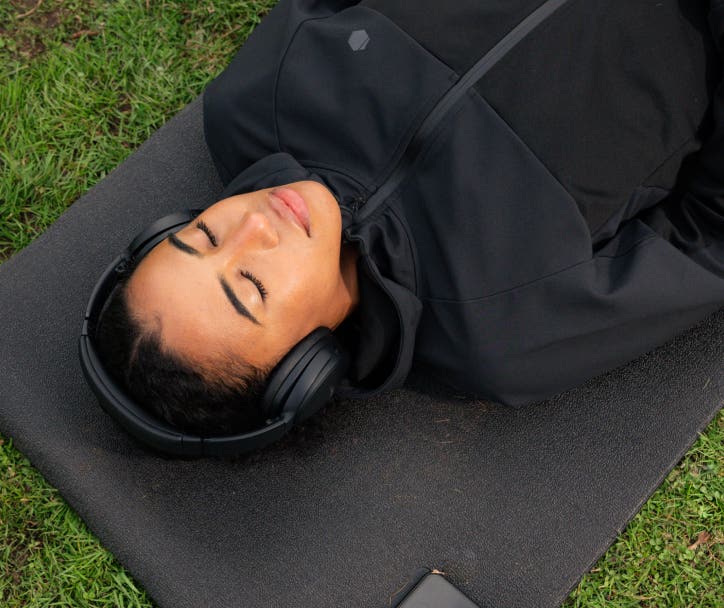No matter where you are in your fitness journey, staying committed to your goals is key. Training hard and consistently – it's just one piece of the puzzle. If you're serious about achieving lasting long-term results, you need to embrace a more holistic approach.
That means fully adopting a healthy lifestyle across every aspect of your daily life, not just on the training ground. In this article, we’ll explore the three key Freeletics pillars that form an athlete’s holistic lifestyle, how they relate to each other, and how you can integrate this approach into your own life.

Pillar 1: Training consistency
When it comes to progressing and improving your overall performance, consistency is everything. And we’re not going to sugarcoat it – it can be tough to commit to regular training sessions, especially with the demands of home, work, and life.
But to build a habit that evolves into lifelong fitness, you've gotta hit your Base consistently. What do we mean? Commit to at least 17 minutes a day of movement. Hike, bike, swim, or simply dance in your living room – just make sure to do it daily to start to create a habit.
Find an activity you enjoy that kick-starts your endorphins, making you feel like you can achieve anything, or at the very least, one that you don’t hate. And don’t be afraid to get creative. Trust us, after a few weeks, you’ll start to notice a difference in how you feel and move.
Once you’ve nailed your Base, try to add on from there. Keep it simple – there’s no need to set unrealistic goals. Start with 2 to 3 additional training sessions per week and commit to doing this for a month before making a session longer or adding another into your schedule.

Pillar 2: Fuel for greatness
Nutrition is paramount for a healthy mind, body, and soul and for crushing your fitness goals. Here are three principles to follow:
- Prioritize whole foods: Focus on incorporating whole foods into the majority of your diet—think fruits, veggies, lean protein, healthy fats, and whole grains. These minimally processed foods provide the essential nutrients your body needs to promote both physical and mental strength while reducing the risk of inflammation and chronic illness.
- Proper hydration: Often overlooked, hydration is the secret weapon to optimal performance and recovery.1 Guzzling down lots of water is not the way, though. Instead, you should be aiming to drink 2 to 3 cups around 2 hours before your workout and take steady sips every 5 to 10 minutes during your training sessions. Post-workout, hydration is vital for recovery, so make sure to keep your fluid levels topped up. You may even need to consider electrolyte replacement.
- Think consistency, not perfection: When adopting a holistic lifestyle, ditch the notion of perfection and prioritize unwavering consistency in every area instead. And that includes your nutrition. Fortunately, with the 80/20 rule—a principle of balance that promotes flexibility while keeping your long-term health goals intact—it's simple to maintain consistency, allowing for occasional indulgences without derailing progress.

Pillar 3: Recovery: Meeting your fitness goals
Being a Free Athlete isn’t just about training hard. It’s knowing when to rest, too. Here are our top tips:
- Training breaks: If you want to progress as an athlete, then you need to rest like an athlete. That means taking enough recovery breaks to allow your muscles to recover and build. New research suggests connections between training frequency and symptoms of overtraining2, emphasizing the necessity of finding balance to reach your goals while ensuring consistency. You should be building recovery days into your exercise and fitness plan from the jump.
- Relaxation techniques: The mental impact of stress can take a serious toll on your fitness journey. Stress is naturally energy-draining, can impact your eating habits, and negatively affect your attitude. So, a good way to combat this is to build relaxation, mindfulness, and breathing techniques into your daily routine.
- Active recovery: Gentle, low-intensity exercise after a strenuous workout can be a great way to encourage muscle recovery. You could try activities such as foam rolling, stretching, swimming, cycling, or hitting your Base. Listen to your body, if you’re experiencing any unusual pain or feel fatigued, you should take a full rest day.
- Sleep: It might sound like a no-brainer, but prioritizing quality sleep is key to rejuvenating your brain, organizing memories, and processing information—setting you up for optimal focus the following day. Plus, sleep isn't just for the mind; it's a game-changer for physical health too, with research showing that it can help improve muscular endurance and power.3
Let’s recap
Body, brain, behavior - they’re all connected. When you improve in one area, you automatically enrich the others. Good nutrition and recovery support training goals. Seeing results from training stokes your motivation, which drives you to set the bar higher and be more disciplined about eating, exercising, and recovering. The cycle repeats. Success builds on success. It isn’t always easy, but it’s the only way to reach your potential.
Sources
[1] Judge, L. W., Bellar, D. M., Popp, J. K., Craig, B. W., Schoeff, M. A., Hoover, D. L., Fox, B., Kistler, B. M., & Al-Nawaiseh, A. M. (2021). Hydration to Maximize Performance and Recovery: Knowledge, Attitudes, and Behaviors Among Collegiate Track and Field Throwers. Journal of human kinetics, 79, 111–122. https://doi.org/10.2478/hukin-2021-0065
[2] Rodrigues, F., Monteiro, D., Ferraz, R., Branquinho, L., & Forte, P. (2023). The Association between Training Frequency, Symptoms of Overtraining and Injuries in Young Men Soccer Players. International journal of environmental research and public health, 20(8), 5466. https://doi.org/10.3390/ijerph20085466
[3] Chen, Y., Cui, Y., Chen, S., & Wu, Z. (2017). Relationship between sleep and muscle strength among Chinese university students: a cross-sectional study. Journal of musculoskeletal & neuronal interactions, 17(4), 327–333.